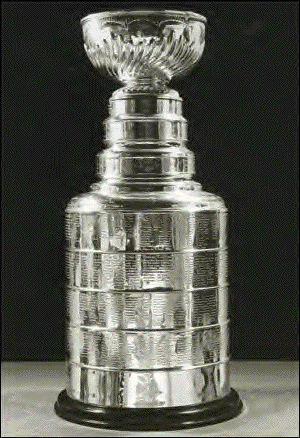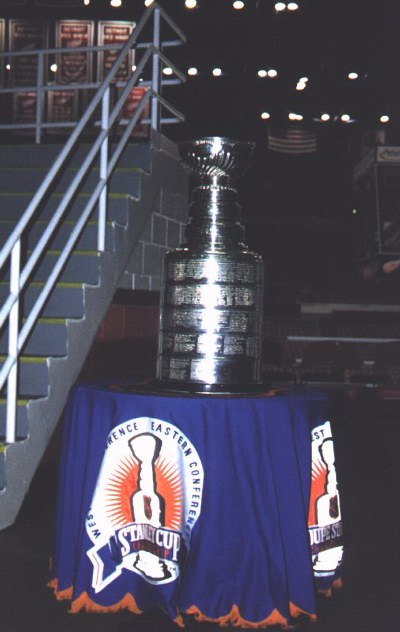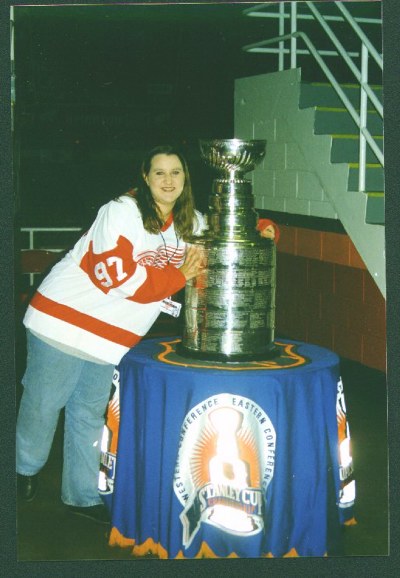My Detroit Red Wings fan site | home
Schedule | Players | 2002 Stanley Cup Champions | The Stanley Cup | Game 7 Western Conferance | Picture's | me & the Wings | News and Gossip | Fans | Related Links | Parade 2002 | NHL's Best Coach | Contact Me | More Wings pixs | Other | 97/98 Champs | 3/02 Boston | Pics of me | Wings #1 Fan
The Stanley Cup
To win the ultimate prize
By Jennifer Nemer
|
|
 |
It's what they work for 84-plus games throughout a season and post.
It's the ultimate prize that brings each NHL player a sense of fulfillment and often awakens the child concealed deep within that player.
It's known as the world's most famous cup, the Stanley Cup, and the Red Wings are vying once again to bring it home to Detroit.
But how did it all this cup frenzy get started?
Well, on March 18, 1892 at a dinner for the Ottawa Amateur Athletic Association, Lord Kilcoursie, a player on the Ottawa Rebels hockey club, spoke on behalf of Lord Stanley, the Earl of Preston and Governor of Canada.
"I have for some time been thinking that it would be a good thing if there were a challenge cup which should be held from year to year by the champion hockey team in the Dominion (of Canada)," Kilcoursie said of Stanley's wishes. "There does not appear to be any such outward sign of championship at present, and considering the general interest which matches now elicit, and the importance of having the game played fairly and under rules generally recognized, I am willing to give a cup which shall be held from year to year by the winning team."
Not too long after the then-called Dominion Hockey Challenge Cup was born. A Capt. Covill was given the task of finding a cup and purchased a silver one, which matches the one on top of today's trophy, measuring seven and a half inches high by 11 and a half inches across for approximately $50. Sheriff John Sweetland and Philip D. Ross, both of Ottawa, were appointed trustees of the cup, (today the position is typically referred to as the "keepers of the cup"); and conditions were placed on the annual prize including:
Though Stanley began the cup pursuit, there's actually doubt of his fervor for hockey. Having returned to his native England in the midst of the 1893 hockey season, Stanley never witnessed a championship game or attended a presentation of his trophy. But it could be said his sons had a major part in the creation of the cup. Stanley's third son, Arthur, was influential in the formation of the Ontario Hockey Association, and along with brother Algy persuaded their father to donate a cup to the newly formed hockey leagues.
It's been 109 years since the Montreal Amateur Athletic Association won the first cup, but the quest still remains strong.
A timeline of the Stanley Cup
1893: The Montreal Amateur Athletic Association became the first winner of the cup.
1907: The Montreal Wanderers became the first team to engrave the names of all their players, in addition to the team name, in the cup. Prior to this, only team names were engraved on the cup's bowl.
1907: An unidentified man held the Stanley Cup for ransom, but the cup was returned without payment from the Montreal Wanderers who had no interest in paying any amount for its return.
1908: The Montreal Wanderers became the first team not to engrave their championship on the bowl.
1925: The Stanley Cup unofficially became the NHL championship trophy.
1948: The NHL remodeled the Stanley Cup into a two-piece trophy with a wider base.
1955: Detroit Red Wings captain Ted Lindsay held up the cup for fans to see and skated along the boards for spectators to have a closer look.
1958: The modern one-piece Stanley Cup was introduced.
1969: The original Stanley Cup was retired to the Hall of Fame.
1971: After Montreal won the Stanley Cup at Chicago Stadium, Canadiens' captain Jean Beliveau skated around the ice with the cup over his head. The rest of the team followed his lead. This began the traditional victory lap.
1977: A Hall of Fame employee attempted to steal the cup. Seven men with tools fled the scene, but police discovered plans and photographs of the Hall in a car parked nearby.
1992: A duplicate Stanley Cup was produced at a cost of $75,000. In a meeting of the NHL, the Hall of Fame, and the Stanley Cup trustees it was agreed the players should always receive the original as a tribute to the work they put in to earning it.
1995: NHL commissioner Gary Bettman decreed every player, trainer, coach and member of management from the Stanley Cup championship team should get at least a day with the cup. Players had been able to spend time with the cup unofficially prior to this, but the decree made it organized, assuring no one would be left out. Part of the agreement included a member of the Hall of Fame must accompany the cup on its many stops.
1996: Colorado's Peter Forsberg became the first player to take the Stanley Cup to Europe, taking it to his native Sweden.
1996: Colorado's Adam Deadmarsh became the first player to have his name corrected on the cup, after it listed him as "Deadmarch."
1997: The cup traveled to Russia for the first time with Detroit Red Wings Igor Larionov, Slava Fetisov and Slava Kozlov.
1998: After winning a consecutive Stanley Cup, the Red Wings gave Coach Scotty Bowman his eighth championship, typing him with Toe Blake for the NHL record as a coach.
2005: The cup's engraving space will be used up and another band will need to be retired.


Me & Lord Stanley